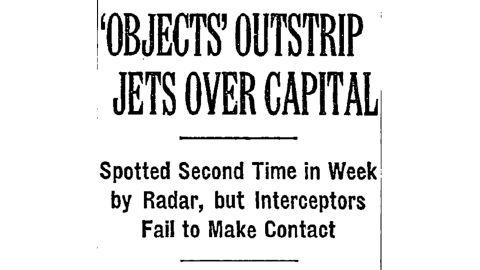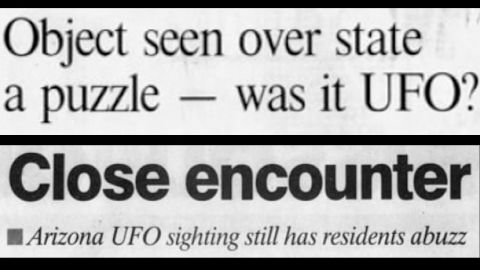With a recently released UFO report, more people are asking about extraterrestrial life. Here’s what that question could reveal – CNN International
Flying saucers. Unexplained lights. Tic-tacs in the skies. UFO sightings have confounded government officials, witnesses and enthusiasts for more than 70 years.
Yet for all the expectations that were put upon an unclassified UFO report released on June 25, it’s only led to more questions than answers.
Its findings, in short: Yes, some things are out there. No, we don’t know exactly what they are.
Though only one of the 144 examined sightings had an official explanation, the US government’s shift from dismissal to open acknowledgment was simply groundbreaking in the eyes of many.
“We’ve shared our skies with these vehicles for a long time, and as we put stigma behind us, we can collectively take a sober, scientific approach to better understand what these are and where they come from,” Luis Elizondo, former director of the Pentagon’s Advanced Aerospace Threat Identification Program, told CNN.
As the topic of UFOs moves from the realms of science fiction to the halls of Congress, our evolving quest to fill in the unknown could still provide some answers. And not just about the phenomenon.
“The narrative is always at the edge of what humanity itself is doing,” sociologist Joseph O. Baker said of UFOs. “As we find out more about space and the universe, the narrative shifts in accordance with that.”
With newly established transparency, researchers say it’s important to keep an open mind as we discover more. And to do that, it’s also important to understand what preconceived notions we bring with us.
How we arrived here
In 1952, unidentified objects caused a national stir after being spotted over the protected DC airspace. One domestic pilot observed bright lights moving across the sky, yet scrambled jets were unable to find the source.
One week later, it happened again. Fighter pilots told investigators they saw bright lights moving away in the distance and could not intercept them.
The sightings sparked headlines across America. While some attempts at explanation pointed to weather, the cause was never fully determined.

It’s unexplained sightings like these that Elizondo researched at AATIP, an investigatory program that studied what it called unidentified aerial phenomena (UAP) for the US government from 2007 to 2012.
“If the American people could see what I and my colleagues in the Pentagon have seen, they’d know that this subject is very, very real, and it’s worthy of thorough study,” Elizondo told CNN.
But UFO coverage moved from national headlines in the 1940s and 1950s to the realms of science fiction after becoming highly stigmatized. Project Blue Book, the US government program that studied UFOs from 1948 to 1969, concluded that the unidentified sightings at the time were not advanced technology or extraterrestrial. During this time and the decades that followed, sensationalized media rushed in to fill the space with fictional tales of extraterrestrial invasions.
And that stigma took root.

In 1997, Arizona Gov. Fife Symington held a press conference after hundreds of witnesses in Phoenix reported seeing a large craft with distinctive lights in the night sky. He jokingly brought out his chief of staff dressed in an alien costume as the supposed culprit.
But a decade later in an editorial piece on CNN, he wrote that he also saw the craft and dismissed an Air Force explanation flares were the cause.
Though historically it’s been easy to write off eyewitness accounts, sightings by US aviators picked up through instrumentation have helped give credence to the topic, Elizondo said. And that evidence has empowered more pilots to speak about witnessed encounters, he said.
According to the unclassified report, 80 of the 144 UFO sightings “involved observation with multiple sensors.” Former Navy pilot Lieutenant Ryan Graves told CBS’ “60 Minutes” in May that pilots along the eastern seaboard have been seeing UFOs “every day for at least a couple years.”
Elizondo also credited forces outside the Pentagon driving the conversation. Legislators are speaking openly about the topic after a bipartisan push over the last decade for government agencies to release information. While still so little is known, Elizondo urged Americans to stay interested and involved, which will give greater incentive for Congress to investigate.
“We need our brightest scientific minds on the job, and I expect that in the coming years, that’s exactly what we’ll see. If we can fully understand them, these technologies hold great promise for humanity.”
How the need to know has changed
In a Gallup poll last month, one-third of Americans said they believed some UFOs are indeed alien spacecraft, and a resounding three-fourths of Americans said that “life of some form” exists elsewhere in the universe.
People’s desire to understand UFOs has always been at the limit of what’s technologically conceivable, said Baker, who studies how society’s views have evolved as an associate professor of the Department of Sociology and Anthropology at East Tennessee State University.
When UFOs first entered the national conversation, the narrative that grew around them was generally positive, Baker said.
“There would be these reports of, say, positive contact with extraterrestrials who supposedly help people achieve like a higher plane of understanding,” Baker said.
But this soon gave way to a more negative connotation, Baker said, as abduction stories dominated the conversation in film and media. The shift made it more difficult to speak freely on the subject and drove speculation toward the fringes, Baker said, and wanting to know more about UFOs must have meant one believed in big-eyed gray aliens.
There was also a change in how Americans viewed their government. As distrust grew, so did conspiratorial thinking.
“You started to see this shift, the idea that the government’s complicit, that the government is part of the problem, that they know about this and maybe they’re even facilitating it,” Baker said.
But the conspiratorial thinking and stigmas traditionally associated with wanting to learn about UFOs isn’t all-inclusive. The widely respected SETI Institute is highly regarded for its monitoring of radio signals in the search for extraterrestrial intelligence.
“Those things are not completely stigmatizing the way it would be if I came to work tomorrow and said I’ve been abducted,” Baker said. “So there is this space again at the edge of knowledge, where even science is willing to say, ‘Well, we don’t know so maybe we should look.’”
Aside from the history of UFOs themselves, modern cultural norms are also changing. About one in four Americans now identify as religiously unaffiliated, according to a 2019 Pew Research survey.
Baker and other sociologists have found that a willingness to accept the possibility of paranormal phenomena such as UFOs is less observed with people strongly tied to organized religion or atheism, and is higher with those who are “moderately religious” or “spiritual but not religious.”
“People say the decline of organized religion is this vast increase in atheism, but that’s not what the polls show,” Baker said. “Instead, we find that the big increases are in this non-affiliated theism, and that’s a boon for the paranormal of all kinds, including UFOs.”
Because the June report offers few definitive conclusions, Baker said its release provides a “blank slate” in which people will project their own ideas of what it means.
How we may handle an ultimate answer
In 2004, Navy Lt. Commander Alex Dietrich and fellow fighter pilots flying off the coast of California intercepted an object they referred to as “the tic tac.”
“It behaved in a way that we were surprised, unnerved,” Dietrich told CNN’s Anderson Cooper in a May interview. “It jumped from spot to spot and tumbled around in a way that was unpredictable.”
The Pentagon officially released footage of the incident in 2020, confirming its existence after videos were earlier leaked.
From a national security standpoint, there’s a greater need for awareness of what these sightings actually are. But there’s a difference between posing a threat and having hostile intent, Elizondo noted.
“I don’t think these vehicles are here to harm us,” Elizondo said. “If they were, they could have done that in the 1940s, perhaps even much earlier.
“But the fact that they have the technological capabilities to do so while our defense architecture publicly pretends like they don’t exist, makes them a threat by definition. That’s quite different from saying that they’re ‘hostile.’”
So how would society and governments across the globe respond if an answer were less straightforward?
Imagine, Elizondo said, how incomprehensible it would have been for President Harry Truman during World War II to have been handed a smartphone for a face-to-face dialogue with Japanese leadership. Such a leap in technology would have baffled many, Elizondo said, and that lesson can be applied to modern day.
“As we learn more about the electromagnetic spectrum and quantum mechanics, the universe becomes accessible in ways we cannot yet fully understand,” he says.
Researchers are working to establish a better base of knowledge around quantum mechanics, including for practical uses like computing that would work exponentially faster. Possibly, an advancement far off in our future could also be applied to travel.
A newfound understanding of the world can turn what was once magical into routine, Elizondo said of the phenomenon.
“There are many rational explanations for these UAP, but all of them are extraordinary,” he said.
As societies change and technologies evolve, we find ourselves asking questions that grow with it. Once we reach the edge of the barrier of understanding, we inevitably feel a need to peer over the fence.
“The many theories that are arising today make it quite clear that we humans are a resilient, curious species,” Elizondo said. “We have a fundamental desire to understand the complexity of our conscious experience and to extrapolate objective truths that can lead us toward a new renaissance.”
And in the search for an explanation for UFO interest, and why humanity’s curiosity can cycle from derision to discovery, the answer could very well be as straightforward as: over the course of time, that’s who we are.
This article has been archived for your research. Find the original article here.


